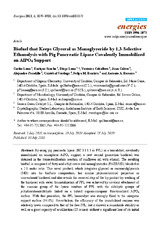Biofuel that Keeps Glycerol as Monoglyceride by 1,3-Selective Ethanolysis with Pig Pancreatic Lipase Covalently Immobilized on AlPO4 Support
Autor
Luna, Carlos
Sancho Puebla, Enrique
Luna, Diego
Caballero, Verónica
Calero, Juan
Posadillo, Alejandro
Verdugo-Escamilla, Cristóbal
Bautista, Felipa M.
Romero, Antonio A.
Editor
MDPIFecha
2013Materia
BiodieselImmobilization
Pig pancreaic lipase (PPL)
Amorphous AlPO4
Selective transesterification
Monoglyceride
Sunflower oil
METS:
Mostrar el registro METSPREMIS:
Mostrar el registro PREMISMetadatos
Mostrar el registro completo del ítemResumen
By using pig pancreatic lipase (EC 3.1.1.3 or PPL) as a biocatalyst, covalently
immobilized on amorphous AlPO4 support, a new second generation biodiesel was
obtained in the transesterification reaction of sunflower oil with ethanol. The resulting
biofuel is composed of fatty acid ethyl esters and monoglycerides (FAEE/MG) blended in
a 2:1 molar ratio. This novel product, which integrates glycerol as monoacylglycerols
(MG) into the biofuels composition, has similar physicochemical properties as
conventional biodiesel and also avoids the removal step of the by-product by washing of
the biodiesel with water. Immobilization of PPL was achieved by covalent attachment of
the ε-amino group of the lysine residues of PPL with the aldehyde groups of
p-hydroxybenzaldehyde linked on a hybrid organic-inorganic functionalized AlPO4
surface. With this procedure, the PPL biocatalyst was strongly fixed to the inorganic
support surface (94.3%). Nevertheless, the efficiency of the immobilized enzyme was
relatively lower compared to that of the free PPL, but it showed a remarkable stability as
well as a great capacity of reutilization (25 reuses) without a significant loss of its initial catalytic activity. Therefore, this enzymatic method allows the production of a biodiesel
which integrates the glycerol, allows a more efficient fabrication method and minimizes
the waste production as compared to the conventional alkali-catalyzed process.

